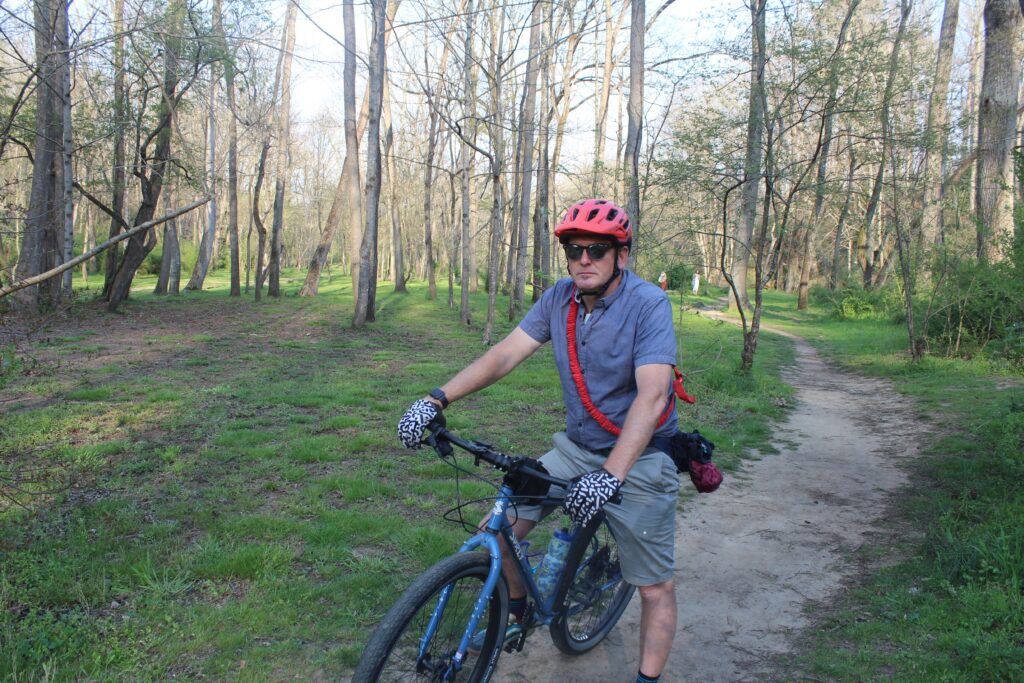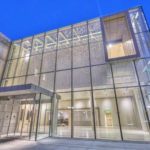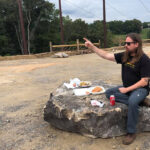
Mike Sule, founder of Asheville on Bikes, is leading a new initiative, called Asheville Unpaved, to create an inner-city system of natural surface biking trails./ photo by Jack Igelman for ASHVEGAS.com
Editor’s note: Jack Igelman is a former trustee and former president of Friends of Hominy Creek Greenway, and is currently coordinating the trail repair project. He’s also a former volunteer with Asheville on Bikes.
Over the past two decades Mike Sule has done just about everything within his power to integrate cycling into Asheville’s urban infrastructure. The founder of Asheville on Bikes likely has his imprint on any piece of cycle-friendly concrete, metal, or paint that’s made a smarter and safer cycling system in Asheville.
Now he’s looking to extend Asheville’s vibrant urban cycling culture beyond the asphalt.
The initiative is called Asheville Unpaved. The vision – along with several initial funding partners that include the City of Asheville, the Friends of Connect Buncombe, and the Pisgah Area SORBA (Southern Off-Road Bicycle Association) – is to create a network of inner-city cycling trails.
“There’s so much pent up demand for active transportation and active recreation in Asheville,” he said. “Everyone wants trail access. We have a very quick transition from urban to natural landscape. It’s very unique to our city and hasn’t yet been tapped.”
At the moment, Sule explained, the idea is still at the starting line. They’ve just contracted with Elevated Trail Design, an Asheville based trail builder, to sort out a concept and the potential scope of an urban trail system. The gist of it is to develop segments of natural surface trails on underutilized public land that connect with trail systems beyond city limits.
Two bright, but isolated examples of urban trails are the two-thirds mile long Hominy Creek Greenway in West Asheville and the recently completed Richmond Hill Bike Park near the French Broad River on the city’s north side. The Richmond Hill trail system, said Pisgah Area SORBA president Craig Ruhland, “allows entry level riders to get a taste of riding and hone the skills necessary to tackle” more technical trails in the area.
You might ask, why build urban trails in town when we have some of the finest trail riding in the nation? Sule’s considered this. For a decade AoB has led a mountain bike skills program at Asheville Middle School. The students, said Sule, get plenty of asphalt riding, but don’t get the opportunity to bomb down single track trails.
“It’s an access issue,” he said. “An urban trail system allows direct access.”
He also claimed that there aren’t enough trails to serve the demand in a post-pandemic world. “Look at Bent Creek. It gets an insane amount of use. To ride there you need to get into a car, buy a bike rack, and find a parking spot. A dense urban trail system should be part of the fabric of the city that provides an opportunity for more people to experience the natural world on a cycle.”
I’ve reported on Sule and his biking crusade for over a decade, and every time I talk to him I feel incrementally more convinced that bikes can transform our city. It’s my opinion that if Sule were a man of the cloth he would be an evangelist. I’m not sure of his theology other than his devotion to bicycles, but it’s certain that his flock – cyclists sometimes outfitted as pumpkins and green fairies – would peddle with him into battle.
But if Sule’s a slick preaching cycling evangelist sharing good news, I’m a gloomy accountant tabulating the costly and lopsided figures of forging and maintaining an off-road urban cycling network.
If you’ve splashed through the Hominy Creek Greenway lately, or any other natural surface trail segment in town, you know what I’m talking about. This past year has been a profoundly damp one. According to the National Weather Service it’s the fourth wettest on record in Asheville.
Here’s how abundant rainfall burdens trail maintenance: runoff settles on portions of the trail and, over time, walkers and bikers trample the surface, packing it tighter. Soon, water, rather than crossing the trail flows down the path forming deeper ruts. More water gains more velocity and energy, washing away soil and cutting deeper into the trail compounding the rate of erosion and holding water longer in muddy puddles.
Currently the Friends of Hominy Creek Greenway is leveraging grant funds and volunteer labor to improve the pathway this spring. But resources are scarce and volunteer driven projects have significant constraints.
The fact is that unpaved pathways require regular upkeep. Sule recognizes the challenges of the project, but points out that Western North Carolina is one of the biking “Meccas of the world. It’s not like we’re flying blind,” he said. “What would happen if we tried. If we leveraged what we have and added to it.”
In fact, urban trail systems are flourishing in other cities. Among them is in Bentonville, Arkansas. Yes, cycling snobs, you heard that right: Arkansas. A town less than half our size publicizes 100 miles of single track in or connected to the city.
Come on Asheville, North Carolina, this is a project we can congregate around. Sule said that he’ll have more to report soon and the initiative will eventually include a round of public engagement and feedback. But it’s going to be a large community lift, he said.
So if you’re a believer in creating an even more bike-friendly Asheville, the offering dish is coming ‘round soon. Let’s all chip in.





















You’re not so much a gloomy accountant as a pragmatist who, like many of us, has been overpromised and underserved.